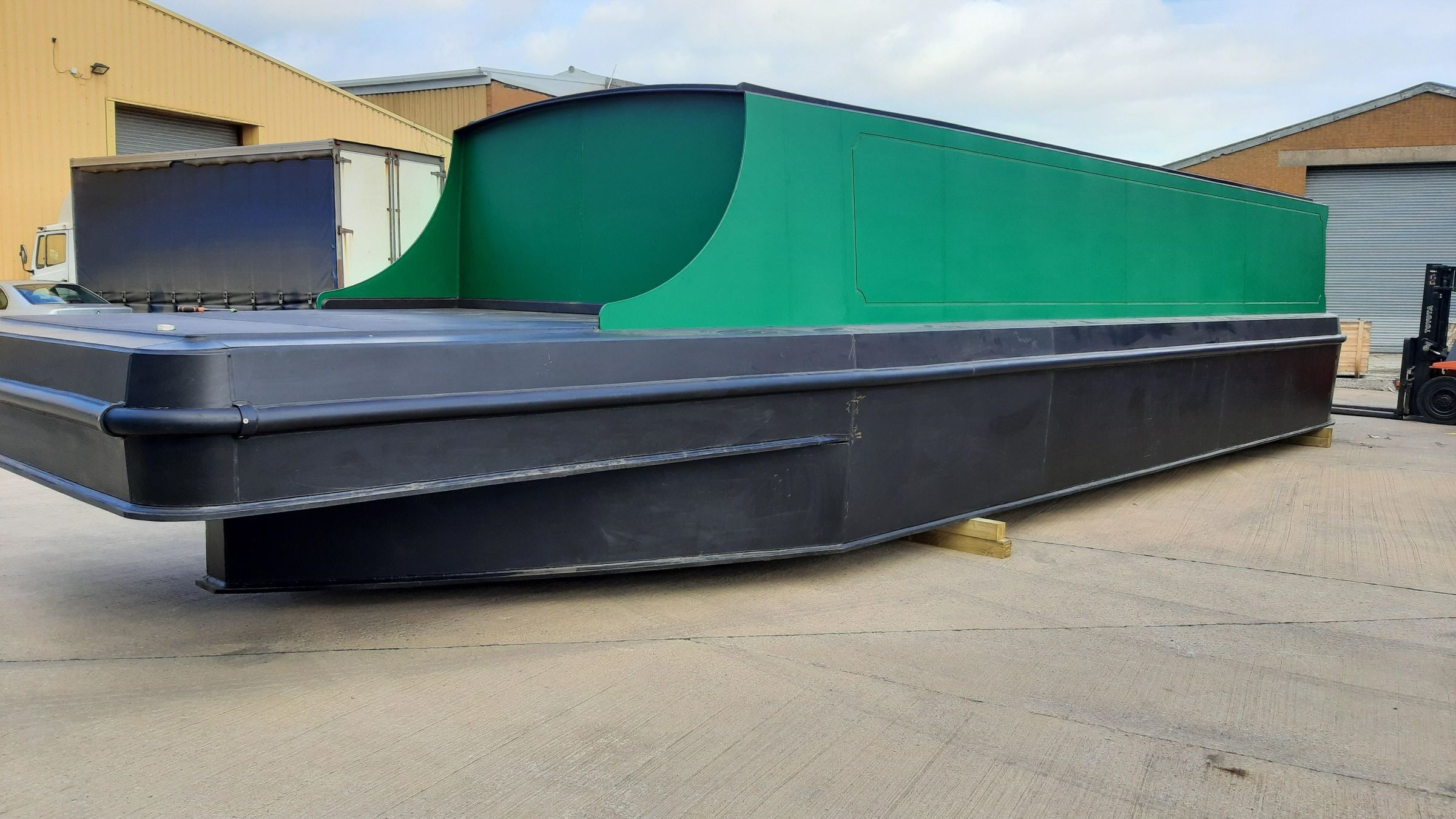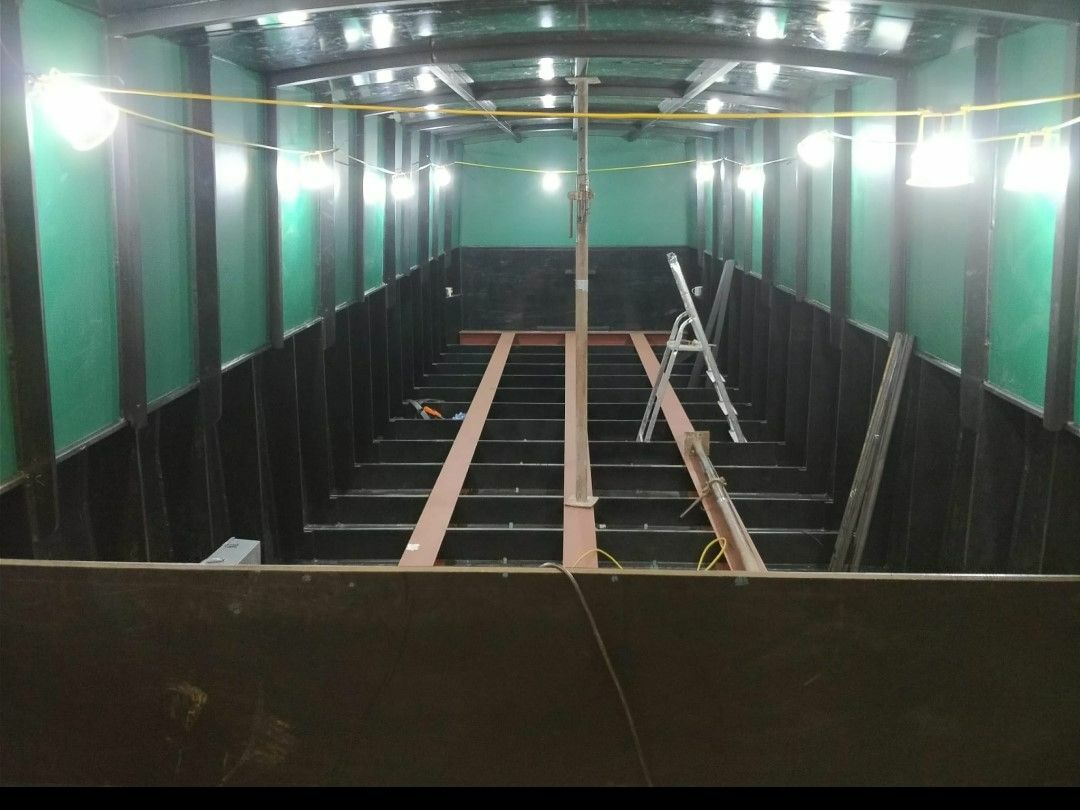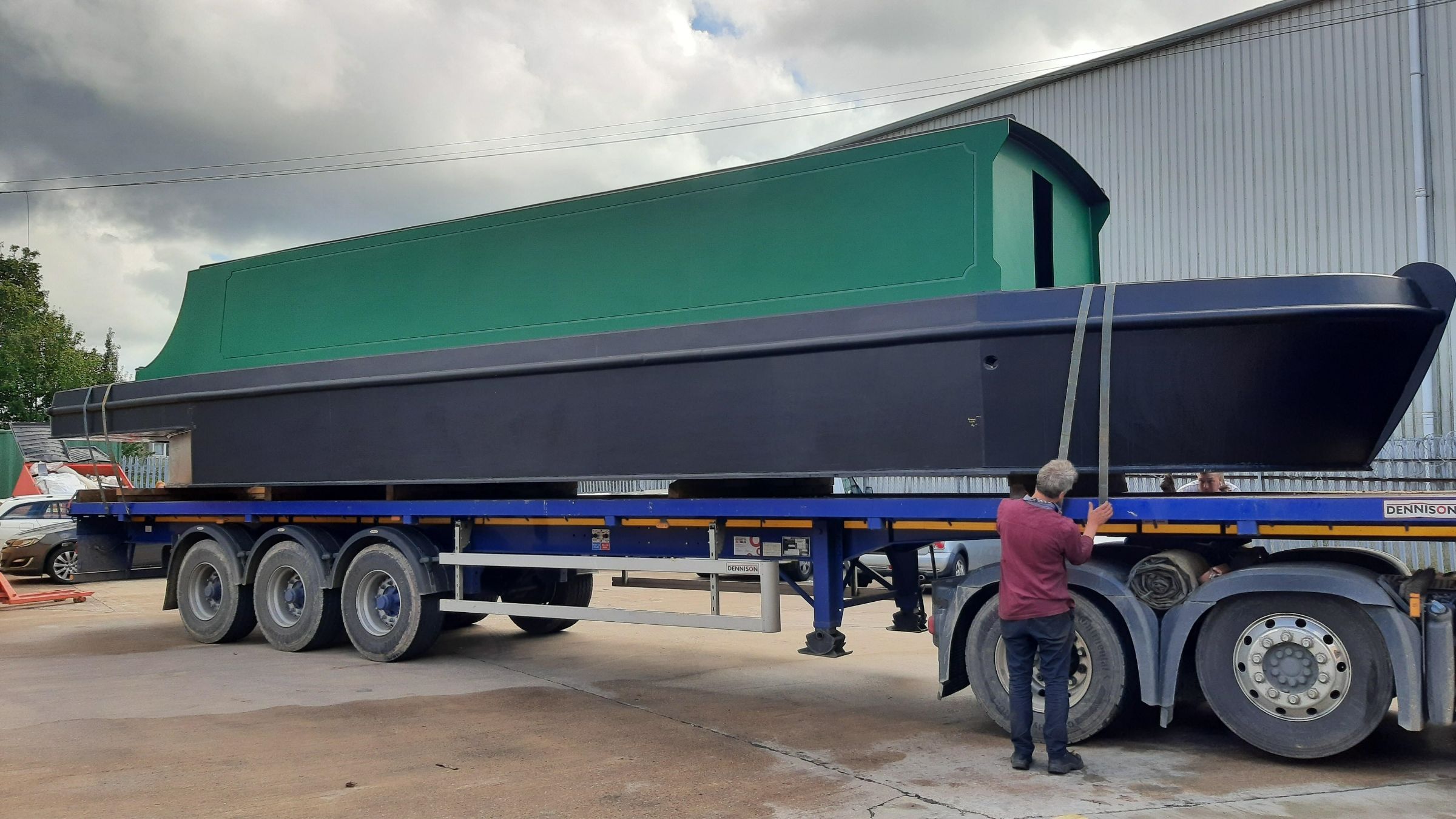-
Posts
18 -
Joined
-
Last visited
Content Type
Profiles
Forums
Events
Gallery
Blogs
Store
Everything posted by shaun15124
-
thank you for this and your feedback has been helpful on so many ways, (now can you pop up to Leeds and help 🙂 )
-
the engine we have in this is is 60hp canaline engine and control panel you're not being negative at all your correct we have done a shell which in the few weeks we are going to be re-fixing issue , then fitting out, etc we know we have a long way to go to get this in the water correctly and fitted out
-
the gypsy lady was built by John Hawkins of D & D engineering the challenges we faced were the sheets we used were 3mtr long and 1.5tr and our challenge was how do we do this without it looking like a patchwork quilt Along with that how will a diesel engine work within a plastic boat? cooling, prop shaft exit, weight, the strength of the hull of the boat, and ballast also there are a lot of long flat sides how would the roof react to expansion and contraction (heat of the sun and freezing temperatures|) 50mm or 2" over 12mtrs from freezing to around 20 C we needed curved edges on the boat mainly the back corners of the boat how can we achieve this on the bow of the boat we need this to make the boat aesthetically pleasing another challenge was how we fit windows to a plastic boat do we use safety glass as with most boats or can we use polycarbonate another issue was plastic is very slippy how can we overcome this for decking ( we used a product called safetech) lot of people think HDPE cannot be painted however we have a primer with a chemical additive that bonds to HDPE making the floor was a challenge as the plastic has to be welded on both sides so no turning over we made jigs and formers for the oven for various parts of the boat the roof was partially designed to allow it to expand ( every 5c increase is equal to 1mm expansion per meter over 12mtr=from freezing to 20c 50mm) we had to look at a simple steel structure to support the base we used an h section of steel beams and is a flat-bottomed boat we now thought we would have an issue with ballast as HDPE is very buoyant and floats we increased the underfloor area to allow for this as said previously we are looking at the best solution for ballast the advance I believe we have achieved so far has proved it is possible to build a boat of this size (of course there are still things to learn) with more investigation this should lend itself to electric propulsion also, a third of the weight of a steel boat needs less than half the power to push it forward never needing blacking every 2 years we have proved something of this size for a plastic boat can be made to look excatly like a traditional boat but this is environmentally friendly moving forward hopefully we could make any size that anyone wished ( it could even just be a hull etc ) if anyone has calculations etc by all means il say this again you more than welcome to come to take a look at this for yourself as we are based in Leeds or even if we had a zoom chat to show you where we are at with it im open to everyone's help on this and appreciate all comments
-
we also have recently got a a naval architect involved who has made numerous HDPE boats and will address certain issue with the canal boat builder, this gentleman was the one who had made the original (gypsy lady ) you have no need to say sorry you are entitled to your opinion and that is why I put this on here to get many different people's opioins on this with the hdpe i totally understand that there are differences in regards to steel and hdpe
-
Apologies if my comment came across in a wrong manner towards the saltwater comment with everything that has been done so far including thickens was recommended by a canal boat builder
-
yea that is one thought actually thank you for that regards to the salty water comment salt water is ok with hdpe actually as HDPE is used a lot in workboats as i have said before and yes I understand there is a difference between a workboat and a canal boat I was merely saying that HDPE is used a lot in all types of environments and I completely get the weight etc issue I must stress as of now we are at a stage where are fixing certain issue
-
Our boat was based on an old canal boat called the gypsy lady, yes, the pictures are the same boat just different camera angles, I appreciated everyone's comments my hope is to have this at shows etc so hopefully, you can all see it for yourself it's resistant to water and chemicals. mechanical composition is extremely strong on impact and tension. Normally the tension resistance is 225-350 kgf/cm2 and heat resistance is above 100 OC. HDPE is widely used in pressure pipes, gas distribution pipes, liquid containers, machine and home appliance parts, and in insulation. Lately, because of its resistance to water, it is also used in tank and boat manufacturing.
-
all brilliant questions and thank you all for your feedback honestly, any advice on fitting this out would be brilliant anyone is more than welcome to come and see this for themselves in the workshop (as I have said I will be getting this back to tweek certain issues and will be showing more pictures of progress )
-
weight is roughly 20t, as nothing is in it ( i know this needs a lot more weight we are looking at many ideas ) in regards to internally, we put ribs in every 600 so you can screw panels, etc ( again this is still ongoing and we have looked at better ways for this not to flex ) to painting you can actually paint HDPE if you wished ( or you can have many colors of hdpe ), vinyl wrap is actually a great idea as well thank you for that thought we put the steel frame for support and rigid in terms of balance we are in the process of this and looking at many options one that has been suggested is pouring concrete in this ( I'm not really sure if that is a good way or not to be honest )
-
When we initially did this the conversation we had with our designer( we had help from a boat designer ) at the time was about making a wide beam and so we agreed that we would make this however, looking back we should have stuck with a narrow boat rather than the wide beam size as most canals are more designed for a narrow boat rather than a wide beam I think if and when we do another one it will be more narrowboat etc size
-
i must Correct something i said The size is 40ft x10ft (not 12ft) this is built using 20mm for the base 15mm for the sides and 12mm for the upper sections
-
yes certain repairs could be done by a capable diyer the best explanation I can give of extrusion welding is very similar to metal welding but instead of using gas you are using hot air
-
this is not me trying to get someone to order a boat actually, this is me try to expose the fact I work for a company that has made this but there has been some publicity on this I am trying to get more I understand that this is a completely new (desgin) hence why I am expecting a lot of questions to it in regards to the Turkish one I was merely trying to say I researched somewhere that had built a bigger HDPE boat and i completely agree that we would need to be heavier
-
thank you all for your comments I appreciate everyone's feedback let me try to answer a few and apologies if I haven't made things clear this boat was made as proof that it can be done we are still working on this boat in regards to other issues and I have taken all your feedback in as you may see there are no windows etc we are actually going to take this back to the workshop in 2 weeks to fix or tweak another issue which I will share with everyone, the biggest HDPE boat that I have found is actually made in turkey which is the size of Length, overall: 16,00 m Length, waterline: 13,8 m (+1A5 L2 PATROL BOAT) Beam, moulded: 4,95 m Depth, moulded: 2.19 m Draught: 0,82 m Speed: 32,5 Kts in regard to HDPE yes this is fully recyclable With the appropriate machine, the film can be cut down into flakes. These flakes can then be dried, melted, and repurposed for a wide variety of products. They are also put through intense levels of cleaning to ensure that they are not contaminated. This guarantees that they do retain the value to ensure that they provide the greatest benefits. The flakes form pellets can be used for a variety of purposes. They can also be combined with virgin HDPE. This ensures that the HDPE plastic provides a higher level of strength and stability. It makes it more useful when it is repurposed
-
Thank you for these very good points currently, there are work boats done out hdpe not only in this country but in other parts of the world, HDPE means High-Density Polyethylene which is a thermoplastic polymer produced from the monomer ethylene. HDPE is known for its high strength-to-density ratio. The density of HDPE can range from 930 to 970 kg/m3. Being lighter than water has an enormous advantage in the marine field. The HDPE is resistant to many solvents making it a perfect choice for the boat building industry. This material is widely used for applications like tanks, pipes, storage containers, etc. Until recently HDPE was not used for boat building considering the challenges that didn’t have a clear solution. Some of the major challenges are how to avoid the bending/buckling of the panels, and how to provide equal strength that is given by other materials. Once these obstacles are tackled, the industry started expanding so fast. Now there are many boat builders around the world started building HDPE boats considering the current demand and the future prospects. Though there is not a straightforward rule book/standard to follow for building these boats, the classification society has come forward to modify their current standards suitable for these boats. I am sure very soon we can expect a separate. FRP/GRP and Carbon fiber are the most commonly used materials. To give a small comparison of these materials a 7m boat hull would require 4mm thickness for aluminum, 7-9 mm for FRP, and 15-20mm for HDPE. HDPE being just 3 times lighter in weight but 5 times thicker compared to aluminum you can figure out the challenges that come with the overall weight. So if the HDPE boat is heavier why is it preferred over other materials? The reason is when it comes to the commercial weight is not the first priority for the owners or builders. The most exciting advantages of HDPE is that its maintenance-free since the surface doesn’t catch barnacles, lighter than water to provide enough buoyancy, exhibits amazing impact strength to provide a smooth ride, recyclable completely to keep the environment safe, and very easy to repair. All these reasons make HDPE the perfect choice for boat owners. Usually once an FRP mold is made it’s not easy to change/customize the design. But with HDPE since it’s a welded panel the design can be modified in every boat. Everything put together HDPE definitely performs better than the other conventional materials in the commercial segment. hope this helps 🙂
-
Hello everyone, I have recently been involved in making a hdpe canal boat And after further investigation, we saw nobody had ever made a canal boat of HDPE, So we had a thought why not? can it be done? and can we, do it? so, after speaking with a professional boat builder (we have actually based our design on an old canal boat called the gypsy lady ) we got to work with the entire process the size is 40ft x 12ft We also found out that HDPE is what is used for a lot of lifeboat builds even fishing boats, especially in turkey and holland due to its strength, we knew that this would be a perfect choice for a canal boat as it will be able to take the unpredictable weather of a canal We used a process called extrusion welding WHY HDPE BOAT HPDE (high-density polyethylene) is a strong and robust material deviated from petrol. Unlike other polyethylenes, HDPE is heavy and firm. Approximately, 1.75 kg petrol is used to produce 1 kg HDPE raw material. HDPE is lighter then water and together with its durability, it becomes a preferred material for marine purposes. HDPE boats can be shaped by molding and extrusion methods. It can be processed in workshops and can be welded with special methods. It is difficult to combine with adhesives. HDPE is a very strong material with a density between 150000 – 400000. Its resistant to water and chemicals. HDPE’s mechanical composition is extremely strong on impact and tension. Normally the tension resistance is like 225-350 kgf/cm2 and heat resistance is above 100 OC. HDPE is widely used in pressure pipes, gas distribution pipes, liquid containers, machine and home appliance parts and in insulation. Lately, because of its resistance to water, it is also used in tank and boat manufacturing. The advantages of HDPE in the boat building are; HDPE Boats' service life is stronger than any boat, made of any other building material: Due to its chemical composition and its very nature HDPE is very durable against aging and corrosion in in marine conditions. HDPE boats' minimum measured life is 50 years. HDPE Boats are almost maintenance free: HDPE is not a corrosive material. Oxygen, salt and water have no effect on HDPE. There is no need for anti-foiling, painting, wintering, dry docking etc. HDPE Boats are very strong: HDPE is not a breakable material. Its very dense and Tension crack resistance and crack running resistance are high, the impacts remain minimum damage. HDPE boats are almost indestructible. HDPE Boats are environmentally friendly: HDPE boats are 100 % recyclable. HDPE boats can be remelted and reshaped for reuse. HDPE boats do not require anti-fouling and therefore do not pose any toxic pollution to nature. HDPE Boats are comfortable: HDPE is not a rigid material. Therefore HDPE boats are very comfortable especially in strong weather conditions, sailing on choppy seas in comparison to rigid conventional boats. Why do we use HDPE? Our indestructible HDPE hulls are specifically designed to be maintenance-free and do not require painting or anodes for protection. Made from 100% recyclable HDPE and built to last a lifetime. Light, strong, and very tough, custom built and finished to your requirements or choose for our existing models. Be the best and put a custom HDPE boat to the test. HDPE hulls do not require painting or antifouling as the very low friction coefficient of the material prevents marine growth from adhering to the material. The properties of HDPE also mean that it is corrosion, chemical and UV resistant and has 0% water absorption. How do we help the environment? HDPE has the lowest carbon footprint of all modern boat-building materials. We can manufacture all boats for environments with sensitive marine ecosystems. if anyone would like to know more please email me on shaun@formationplastics.co.uk








